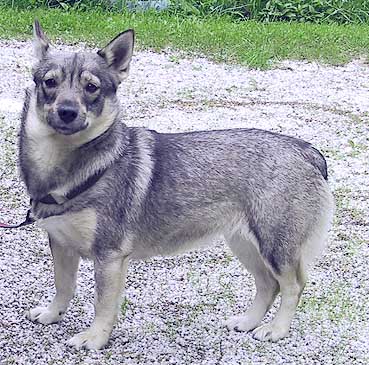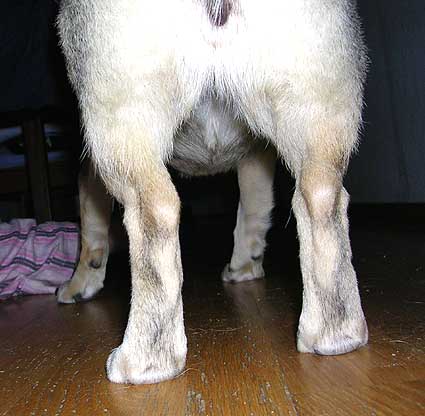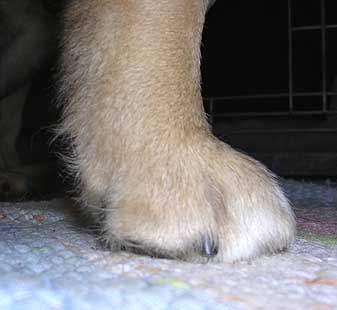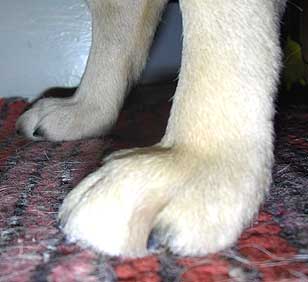

Examples of different qualities
General appearance | Head | Eyes | Ears
| Neck | Body
Limbs | Feet | Coat | Colour and markings
| Height | Tail
General appearance : on the left is a male that is more heavily built than the bitch on the rigth. Both sexes should be easily distinguishable. A Vall should be a sturdy little dog, one that looks like it could work all day without becoming tired.
Head : the bitch on the left has a straigth forehead and clear facial markings. The male on the rigth has a more rounded forehead and facial markings that are not so clear. Both dogs have dark lips and black underjaw, which both are desirable qualities. The male has loose lips whereas the bitch has tigth lips, like they shoud be.
Facial markings and expression are good in both of these dogs.
Eyes : the male on the left has a bit too lightly coloured eyes. The bitch on the rigth has vey dark eyes.
Ears : Both dogs have medium sized ears that are pricked and set in a correct position.
Neck : the neck is long, has strong muscles and good reach. The male on the rigth has an otherwise nice neck but it could be a little longer.
Body : Both of these dogs have a level and strongly muscled back, short and strong loin, broad and slightly sloping croup and long chest with good depth. Ribs are well sprung. Musculature is strong, especially on the male on the right.
Fore - and
hindquarters : the bitch above has a sligthly less bone than she should have and her chest is a bit too wide.
The male on the left below has both a good front- and hindlimb alignment, frontfeet quite straight and pointing forward, hindfeet parallel when viewed from behind. Strong bone and strong, well-muscled thigs and well angulated stifle and hock. Also the appearance of the hindquarters of the bitch on the right below is good except it is lacking a bit of bone.
Angulation : (sidewiew)


Hindquarters : (on the left) Long lower thigh, good angulation on the knee and the hock. Strong muscles in the thigh.
Forequarters : (on the rigth) Shoulder is long, the upper arm is slightly shorter than shoulder blade and close fitting to ribs, but still very mobile. Elbows are turning neither in nor out. Forearm, when viewed from front, are slightly bent, just enough to give free action at chest´s lower part. Pastern is springy and maybe a bit too long in the picture on the rigth.
Feet :
Frontfeet (above) : on the left a round frontfoot, on the rigth an oval foot
Hindfeet (below) : on the left a round hindfoot, on the rigth an oval foot


Coat : Undercoat very dense and soft with medium length, harsh, close and tight topcoat. Smooth on head and front of legs, longer on neck, throat, chest and backside of legs. The male on the left has a longer coat. The bitch on the rigth has the ideal coat type. This type of coat is weatherproof and easy to maintain.
Colour and markings : Preferred colours are grey, greyish brown, greyish yellow, reddish yellow, reddish brown. Lighter hair shades of colour as mentioned is desirable on muzzle, cheeks, throat, chest, belly, buttocks, feet and lower part of legs. Darker guard hairs on back, neck and sides of body. Lighter markings over the shoulders, "harness markings", are preferred. The male on the left is of a darker grey colour that the bitch on the rigth. The mal has also white marking. Both of these dogs have the right colouration for the breed. White markings are accepted on chest and on the front- and hindlegs.
Height :
the ideal heigth : for the male is 33 cm for the female it is 31 cm
the variation of +/- 1 cm is allowed,
so the heigth of male ranges from 31-34 cm and for females the range is 30-32 cm
From the picture above you can see the difference in sizes between a robust, much larger male and a small, lightly built female.
Tail : Two types of tail occur; long or natural short tail. In both cases all variations are acceptable. So the tail of a Vall can vary from no tail to a full sized tail. On the left is a one vertebrae long bob tail, on the center is a spitz type, curled tail and on the rigth the same tail carried low. The bob can be anything from few centimeters long up to a half-sized tail. The long tail can be carried down or be curled in many different ways.
|
Navigation |